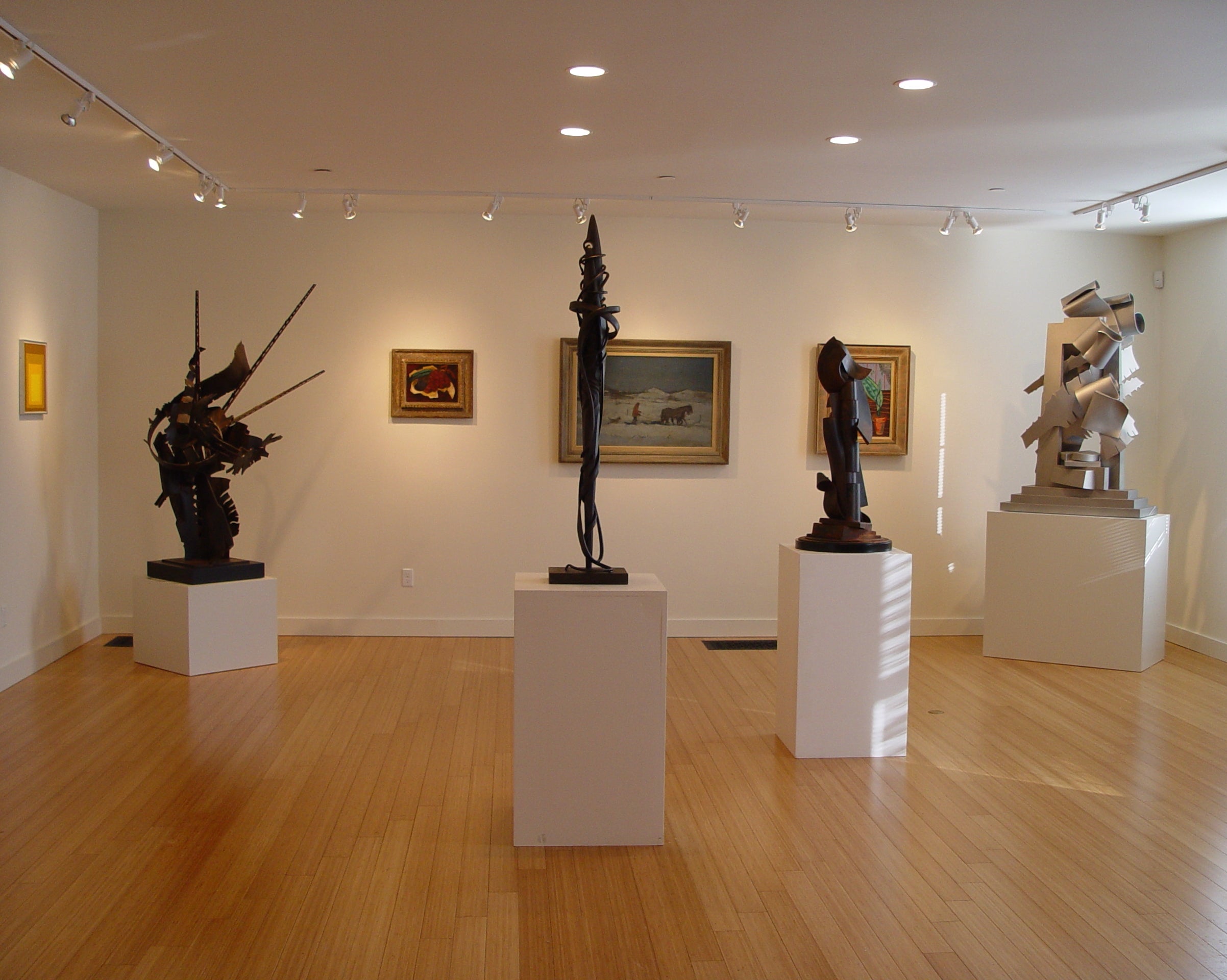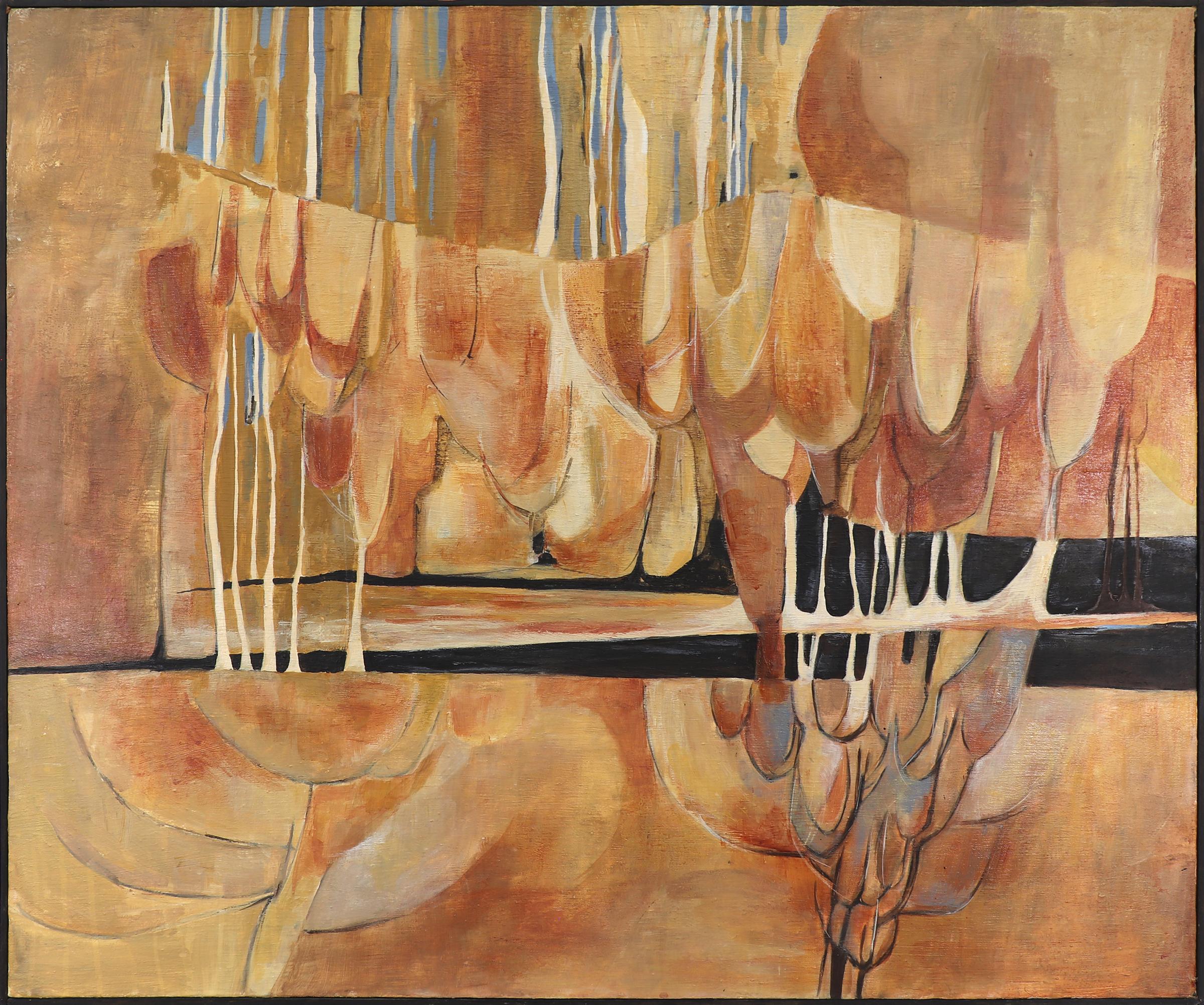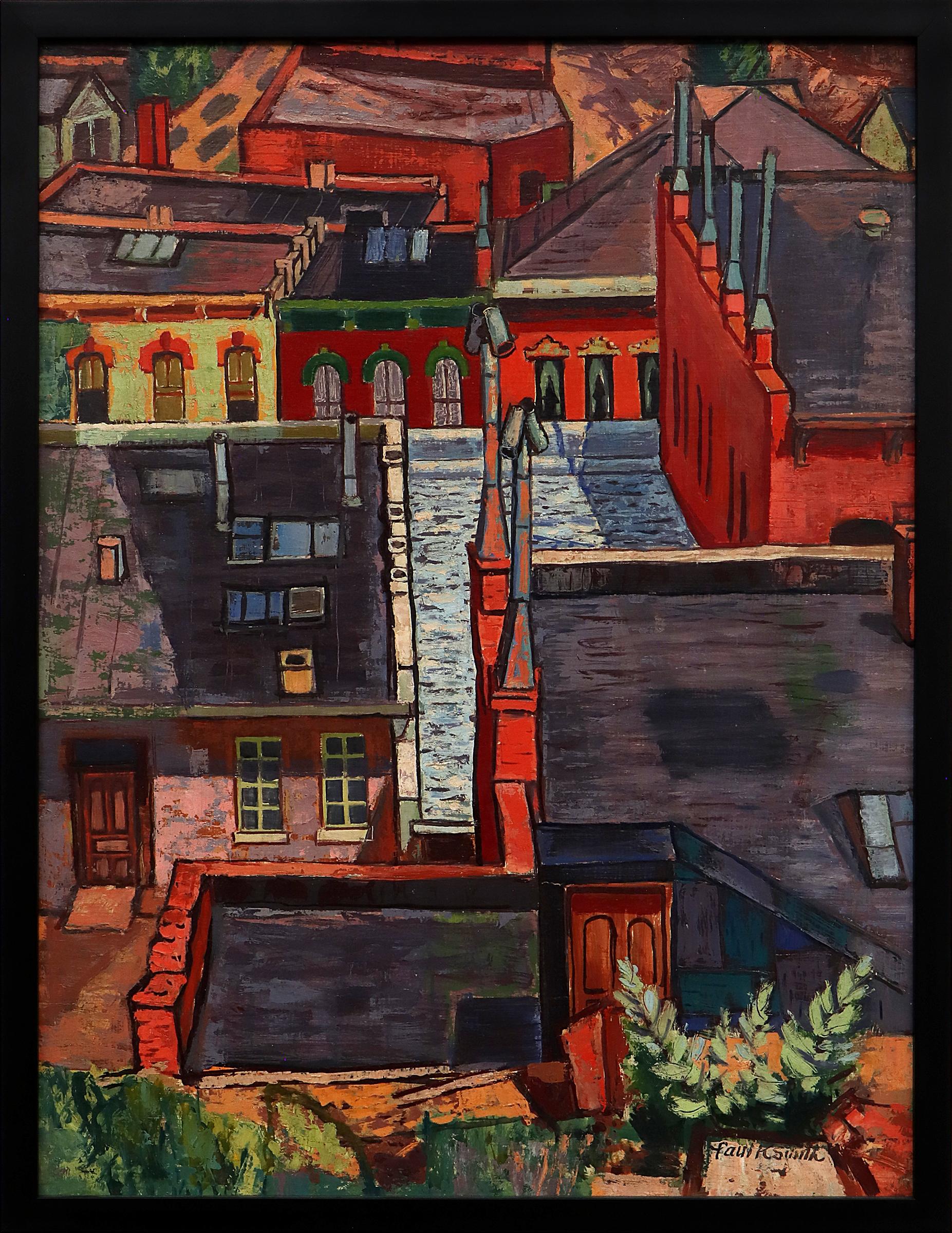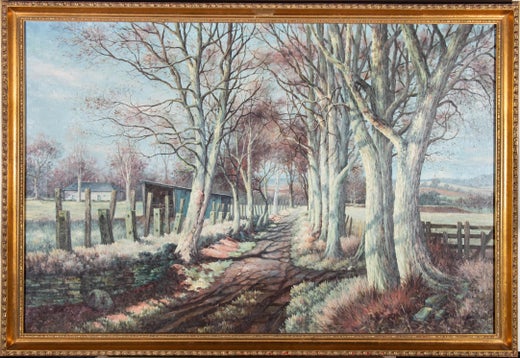Grace Hill TurnbullWaterfall (Woodstock, New York)c. 1925
c. 1925
About the Item
- Creator:Grace Hill Turnbull (1880 - 1976, American)
- Creation Year:c. 1925
- Dimensions:Height: 14 in (35.56 cm)Width: 20 in (50.8 cm)
- Medium:
- Movement & Style:
- Period:
- Condition:
- Gallery Location:Concord, MA
- Reference Number:1stDibs: LU354557702
Grace Hill Turnbull
Grace Hill Turnbull was born in 1880 in Baltimore, Maryland. As times and the climate of the art world changed, her work in painting varied from traditional portraits to modernist figures in landscapes. In 1914 in Paris, France, she was awarded the Whitelaw Reid First Prize. She exhibited in the annual exhibitions of the National Association of Women Painters and Sculptors in New York City, including their 45th and 50th shows in 1936 and 1942. Her first experience as a sculptress was at age 13 when she and her brother Bayard built a miniature white marble church at the family's summer home. She was considered very avant-garde when she started painting around the beginning of the 20th-century, first portraits and then landscapes and flowers. In 1928, she moved into her house in Guilford, designed by her brother Bayard, and concentrated on creating sculptural work. Turnbull worked as a sculptor into advanced age and she also authored several books. She died in Baltimore in 1976.

- ShippingRetrieving quote...Ships From: Concord, MA
- Return PolicyThis item cannot be returned.
- The FactoryBy Gregorio PrestopinoLocated in Concord, MAGREGORIO PRESTOPINO (1907-1984) The Factory, c. 1935 Oil on canvas 30 x 24 inches Signed at lower left: Prestopino Born in the Little Italy section of New York City, Prestopino was awarded a scholarship to the National Academy of Design at the age of fourteen. Early in his career he came under the influence of the French Impressionists, but was soon drawn to the American realists of the Ashcan School, whose work led him directly to the study of urban life. As a young man Prestopino set up his first studio in Harlem. During the 1930s his social realist paintings had an anecdotal quality in their description of everyday incidents of the working class, depicting the grit of city life – docks, laborers, vendors, Lower East Side streets. Prestopino lived in Brooklyn for many years, spending summers at a farm near Clinton, New Jersey. At the farm Prestopino painted in the barn, while his wife - illustrator Elizabeth Dauber - had a studio in the house. He moved to Roosevelt, New Jersey in 1949. Other artists who have lived in Roosevelt include Ben and Bernarda Shahn, their son Jonathan Shahn, Jacob Landau, David Stone Martin and his son, Stefan Martin...Category
1930s American Modern Figurative Paintings
MaterialsOil, Canvas
- Space TravelBy Philip PerkinsLocated in Concord, MAPHILIP PERKINS (1907-1970) Space Travel, 1945 Oil on canvas 10 x 8 ¼ inches Dated on canvas verso: 1945 Titled on stretcher bar: Space Travel Unsigned Philip Perkins was bor...Category
1940s American Modern Abstract Paintings
MaterialsCanvas, Oil
- Frenchman Bay, Mount Desert Island, MaineBy Charles Henry GiffordLocated in Concord, MACHARLES HENRY GIFFORD (1839-1904) Frenchman Bay, Mount Desert Island, Maine, 1874 Oil on canvas 12 x 20 inches Signed and dated at lower right:...Category
19th Century Abstract Impressionist Landscape Paintings
MaterialsCanvas, Oil
- On the Marmaton River, Kansas,By Benjamin HartleyLocated in Concord, MABENJAMIN HARTLEY (1838-1912) On the Marmaton River, Kansas, 1880 Oil on board on canvas 6 x 9 ¾ inches Signed and dated at lower right: B. Hartley / 1880 Titled and dated in artist’s...Category
1880s Abstract Impressionist Landscape Paintings
MaterialsBoard, Oil, Canvas
- Swing,By Ray DonarskiLocated in Concord, MARAY DONARSKI (1935-1996) Swing, 1966 Oil on canvas 17 ½ x 17 ½ inches Signed, dated and inscribed verso: ‘Swing’ / Ray Donarski / 2/66 / 17 ½ x 17 ½ / For Mr. & Mrs. Passerman / New York 1966 Original frame Ray Donarski was one of a group of artists in New York known as the Bowery Boys during the early sixties. The group included Eva Hesse, Robert Mangold, Jack Youngerman, and Robert Rauschenberg among others. He is mentioned in several of art critic Lucy Lippard's articles on New York conceptual artists and Bowery Boy artists of that period. Donarski was a close friend of artist James Rosenquist. They had studied together at the Art Students League in New York. In January of 1962 Donarski helped Rosenquist set up his first solo exhibition at the Green Gallery in New York. In his book, Painting Below Zero: Notes on a Life in Art, Rosenquist recalls sitting on the floor with Donarski before opening night wondering if anyone would show up. The show sold out before it opened. When Rosenquist was broke and homeless in 1955 his friend Donarski told him he knew of a great job as a chauffeur and bartender for some very wealthy people. They went up to see them and split the job. Rosenquist took it for a year, and after a year, he gave it to Donarski. In an interview with Rosenquist he said “I lived in the lap of luxury with very little money, and was a chauffeur bopping around in a ’56 Lincoln town car and a ’56 Lincoln convertible with big fins on the car (laughs), great big fins. I did that for a year and then transferred into the International Sign Painters.” Donarski married Mary Lou Storm and had two children. He became known as the “American in Luxembourg”, dividing his time between New York and summers in Luxembourg, where he was represented by Galerie Paul Bruck and Galerie Horn. He also exhibited at the Westport Gallery...Category
1960s Abstract Geometric Abstract Paintings
MaterialsCanvas, Oil
- Untitled AbstractLocated in Concord, MABUDD HOPKINS (1931-2011) Untitled Abstract, 1964 Oil on paper on canvas 14 x 11 inches Signed and dated at lower right: Hopkins ‘64 Budd Hopkins was born in Wheeling, West Vi...Category
1960s Abstract Expressionist Abstract Paintings
MaterialsCanvas, Oil, Paper
- Forest, American Modernist Abstract Landscape Painting by Female ArtistLocated in Doylestown, PA"Forest" is a 29 x 36 inches, oil on canvas painting by American modernist, female artist Peter Miller. The work is painted in a vibrant color palette. The work is estate stamped on ...Category
1940s American Modern Abstract Paintings
MaterialsCanvas, Oil
- Amish Farmscape #3By Edmund LewandowskiLocated in Los Angeles, CAAmish Farmscape #3, 1984, oil on canvas, 40 x 30 inches, signed and dated lower right; signed, dated, and titled verso About the Painting Amish Farmscape #3 is part of a multi-painting series of barns completed in the early 1980s for an exhibition at New York’s prestigious Sid Deutsch Gallery. Lewandowski painted this work at an important point in his career. It was the first major project undertaken by Lewandowski after his retirement from serving as the Chairman of Winthrop University’s Art Department, the last academic position he held after teaching for nearly thirty years. Lewandowski had been inspired to work on the series by a visit to Lancaster County, Pennsylvania. Like his friend and mentor, Charles Sheeler, Lewandowski had always been fascinated by vernacular architecture and the Amish barns of Pennsylvania brought back memories of rural scenes Lewandowski had painted in the Midwest much earlier in his career. Amish Farmscape #3 is a strong example of Lewandowski’s late precisionist work. The complexity of the composition and Lewandowski’s technical acumen are on full display. Being relieved of the burdens of teaching and administering a university art department likely allowed Lewandowski greater freedom and most importantly more time to complete the Amish Farmscape series. Although Lewandowski’s brand of precisionism changed throughout the years, he never deviated from the core tenets of the Immaculate School artists. In this work, we see simplified and flattened forms, the use of ray-lines to define light and space, the elimination of extraneous details, a polished almost machine-like finish, and the complete lack of visible brushstrokes, all hallmarks of the precisionist painters. Lewandowski was the last of the 20th century precisionists and in Amish Farmscape #3, we see just how successfully he continued to work in this style until his death in 1998. About the Artist Edmund Lewandowski was among the best of the second-generation precisionist painters. He was born and raised in Milwaukee, Wisconsin and studied at the Layton School of Art with Garrett Sinclair. Lewandowski achieved early success when in 1936 two of his watercolors were shown at the Phillips Collection as part of a Federal Art Project exhibition. Then, in 1937, his work was first exhibited at Edith Halpert’s Downtown Gallery which represented Lewandowski into the 1950s. Under Halpert’s guidance, Lewandowski continued to explore watercolor as his main medium during the 1930s and 1940s, since the gallery already represented Charles Sheeler, who worked primarily in oils. Sheeler became Lewandowski’s major influence as the primary leader of the ill-defined, but very recognizable Immaculate School artists, which included other Downtown Gallery painters, Niles Spencer, George Ault, and Ralston Crawford, as well as Charles Demuth and Preston Dickinson, both of whom died at a young age and had been represented by the Charles Daniel Gallery. Sheeler is credited with giving Lewandowski technical advice on how to make his paintings more precise and tightly rendered and by all accounts, Sheeler was a fan of Lewandowski’s work. Through the Downtown Gallery, Lewandowski’s paintings were accepted into major national and international exhibitions and purchased by significant museums and collectors. Franklin and Eleanor Roosevelt and Nelson Rockefeller acquired works by Lewandowski. He was included in the Museum of Modern Art’s important 1943 exhibition, American Realists and Magic Realists as well as juried exhibitions at the Whitney Museum of American Art, the Pennsylvania Academy of Fine Arts, and the Art Institute of Chicago. Lewandowski also completed commissions for magazines during the 1940s and 1950s, including several covers for Fortune. Throughout his career, Lewandowski explored urban and rural architecture, industry, machinery, and nautical themes. Looking back on his career, Lewandowski wrote, “My overwhelming desire as an artist through the years has been to record the beauty of man-made objects and energy of American industry on canvas. For as far back as I can recall, the cityscapes, farms and depictions of industrial power and technological efficiency has had a great attraction for me. I try to treat these observations with personal honesty and distill these impressions to a visual order.” Lewandowski is credited with extending precisionism to the Midwest and successfully continuing the style into the 1990s, three decades after Sheeler’s death and six decades after Demuth’s passing. Late in his career, Lewandowski enjoyed a resurgence of popularity as he was represented during the 1980s by New York’s Sid Deutsch and Allison Galleries...Category
Mid-20th Century American Modern Landscape Paintings
MaterialsCanvas, Oil
- Salutations, Architectural Abstract Scene, Cultural and Spiritual CommentaryLocated in Doylestown, PA"Salutations" is a 12 x 16 inches, oil on canvas painting by American modernist and surrealist, female artist Peter Miller. The work is painted in a vibrant color palette. The painti...Category
1940s American Modern Abstract Paintings
MaterialsCanvas, Oil
- American Modernist Abstract Landscape Oil Painting of Trees, Yellow Orange BlueLocated in Denver, COMid 20th Century abstracted landscape pen and oil painting with trees by American Modernist Henriette "Yetti" Stolz, signed on the back of the painting. Portrays a modernist landscape of a forest with trees, painted in shades of gold, brown, orange, and blue. Presented in a vintage frame measuring 30 ¾ x 36 ¼ inches. Image measures 30 ¼ x 35 ¾ inches. Provenance: Estate of the Artist, Henriette "Yetti" Stolz Painting is in good condition - please contact us for a detailed condition report. About the Artist: Henriette “Yetti” Stolz was born in Serbia in 1935 ( and is still living ). Her family emigrated to Denver, Colorado, in the early 1950s after WWII and she attended East High School before studying art at Colorado College, in Colorado Springs in the mid to late 50s. While there studying she would have been exposed to modernist artists working both at the college ( ie. Mary Chenoweth...Category
Mid-20th Century American Modern Abstract Paintings
MaterialsCanvas, Ink, Oil
- Central City, Colorado, 1950s Modernist Cityscape Oil Painting with BuildingsLocated in Denver, COOil on canvas modernist city scape painted circa 1950 by Paul K Smith (1893-1977) titled Central City, Colorado. Portrays a city scene of historic buildin...Category
1950s American Modern Landscape Paintings
MaterialsCanvas, Oil
- Orbs, Spiritual and Abstract LandscapeLocated in Doylestown, PA"Orbs" is a 38 x 50 inches, oil on canvas painting by American modernist and surrealist, female artist Peter Miller. The work is estate stamped 202141 on verso. The painting has been...Category
1950s American Modern Abstract Paintings
MaterialsCanvas, Oil



